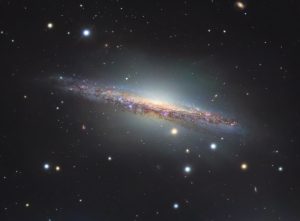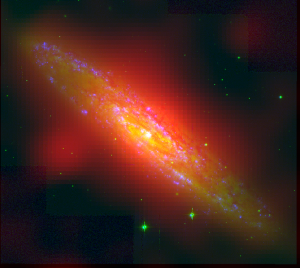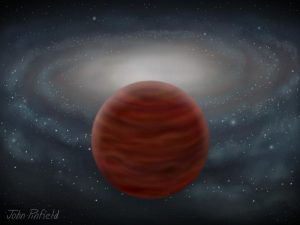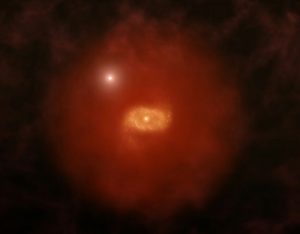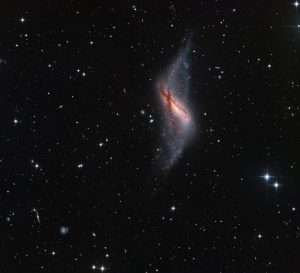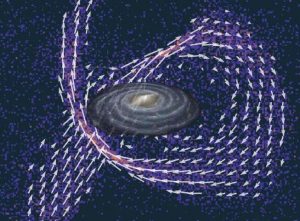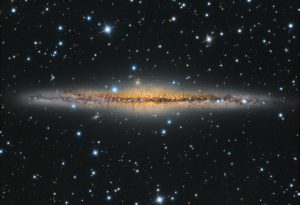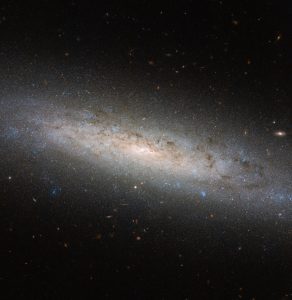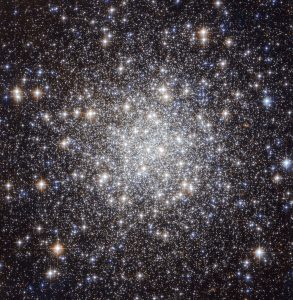alone galattico
Un Primo Piano di NGC 1055
La bella, grande galassia a spirale NGC 1055 è una rappresentante importante di un piccolo gruppo di galassie a circa 60 milioni di anni luce di distanza nella Costellazione della Balena. Continua a leggere
L’Alone di una Galassia Starbust
Gli astronomi hanno utilizzato un radiotelescopio nell’outback australiano per osservare l’alone di una vicina galassia starbust con dettaglio senza precedenti. Continua a leggere
La nana bruna più pura e più massiccia
Un team internazionale di astronomi ha identificato una nana bruna da record, con la composizione più “pura” e la più grande massa conosciuta. L’oggetto, noto come SDSS J0104+1535, fa parte dell’alone della nostra galassia. Continua a leggere
Baby galassie Avvolte in Super aloni
Grazie ai sensibili strumenti di ALMA gli astronomi hanno ottenuto lo straordinario risultato di osservare direttamente due galassie remote, simili alla Via Lattea com’era quando l’Universo aveva soltanto l’8 percento della sua età attuale. Continua a leggere
NGC 660: una galassia ad anello polare
Questa bella immagine riprende NGC 660, una galassia ad anello polare ad oltre 40 milioni di anni luce di distanza nella costellazione dei Pesci. Le galassie ad anello polare sono rare e sfoggiano una considerevole presenza di stelle, gas e polvere che orbitano in anelli notevolmente inclinati rispetto al piano del disco galattico. Continua a leggere
Gruppi di Stelle come Stormi di Uccelli
Molte stelle dell’alone che circonda la nostra galassia viaggiano in gruppo, come stormi di uccelli, secondo recenti analisi basate su dati della missione Gaia dell’ESA, volta a ottenere una mappa tridimensionale della Via Lattea. Continua a leggere
NGC 891: Una Straordinaria Visione di Taglio
La grande galassia a spirale NGC 891 si estende per circa 100.000 anni luce ed è visibile dalla nostra prospettiva quasi perfettamente di taglio. Infatti NGC 891, a circa 30 milioni di anni luce di distanza nella costellazione di Andromeda, ha un aspetto molto simile alla nostra Via Lattea. Continua a leggere
Stelle Intruse ai confini della Via Lattea
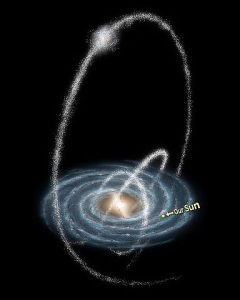 Le undici stelle più lontane che conosciamo nella nostra galassia si trovano a circa 300 mila anni luce da noi, ben al di là del disco a spirale della Via Lattea. Nuovi studi da parte di astronomi di Harvard mostrano che metà di quelle stelle potrebbero essere state strappate via ad un’altra galassia: la Nana del Sagittario. Per di più, esse appartengono ad un lungo flusso di stelle che si estende per un milione di anni luce nello spazio: 10 volte la larghezza della nostra galassia. Continua a leggere
Le undici stelle più lontane che conosciamo nella nostra galassia si trovano a circa 300 mila anni luce da noi, ben al di là del disco a spirale della Via Lattea. Nuovi studi da parte di astronomi di Harvard mostrano che metà di quelle stelle potrebbero essere state strappate via ad un’altra galassia: la Nana del Sagittario. Per di più, esse appartengono ad un lungo flusso di stelle che si estende per un milione di anni luce nello spazio: 10 volte la larghezza della nostra galassia. Continua a leggere
Il Lato Oscuro di NGC 24
Questo disco luminoso e scintillante di galassia a spirale si trova a circa 25 milioni di anni luce dalla Terra nella costellazione dello Scultore. Chiamata NGC 24, la galassia è stata scoperta dall’astronomo William Herschel nel 1785, e si estende per circa 40.000 anni luce. Continua a leggere
Nuova luce sulle prime stelle dell’Universo
Un team di astronomi dell’Università di Notre Dame ha individuato quella che potrebbe essere la seconda generazione di stelle, rivelando nuovi indizi sulla natura dei primi astri nati nell’Universo. Continua a leggere
